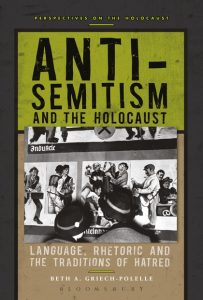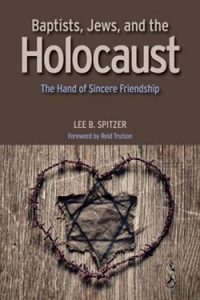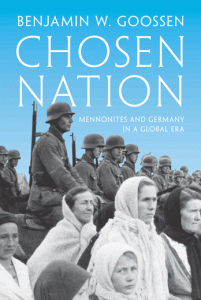Contemporary Church History Quarterly
Volume 25, Number 1 (March 2019)
Review of Beth A. Griech-Polelle, Anti-Semitism and the Holocaust: Language, Rhetoric and the Traditions of Hatred (New York: Bloomsbury, 2017). 284 pp. ISBN: 9781472586919.
By Kyle Jantzen, Ambrose University
Beth A. Griech-Polelle’s book enters the market of Holocaust history as a thoroughly accessible and carefully constructed overview of the Shoah, beginning quite properly in the long history of antisemitism that lay behind the mass murder perpetrated by the Nazis and their collaborators. The author states from the outset that she is interested in “the theme of the power of language and how language and rhetoric can result in deadly actions” (1). Drawing on the work of the French political scientist Jacques Semelin, Griech-Polelle notes that a society’s ideological concerns around “identity, purity, and security” can be impacted by “destructive legends, myths, and stereotypes” that generate caricatures which create fears that “enemy outsiders” will “defile, pollute, and destroy … us” (1). In like manner, she uses Thomas Kühne’s work on persecution as community-building and Saul Friedländer’s notion of redemptive antisemitism to argue that “language and rhetoric influenced the construction of ‘the Jew’ as eternal enemy” and that “language led to the violence and annihilation of European Jewry in the Holocaust” (2). Anyone familiar with Alon Confino’s insightful book A World Without Jews: The Nazi Imagination from Persecution to Genocide (New Haven: Yale University Press, 2015) will recognize Griech-Polelle’s approach and be reminded of the ways in which language contributed to the creation of a culture—a social imaginary, to invoke Charles Taylor’s term—that made possible the Nazi persecution of the Jews and, ultimately, the Holocaust.
 Griech-Polelle begins with the rise of religious antisemitism—rooted in the concept of Jews as “Christ-killers’’—in the biblical accounts of Jesus’ arrest, death, and resurrection. With the emergence of Christianity came the belief that the Early Church was the “New Israel” which replaced the Jews as God’s chosen people (10-11). Tracing the loss of Jewish rights in the late Roman Empire, the author shows how the Codex Theodosianus began to impose restrictions on Jews and to generate the segregating language that would shape the medieval era. Through the period of the crusades and on into the Middle Ages, Griech-Polelle explains important incidents in the history of Jewish persecution, but beyond that, she endeavours to outline the way a particular kind of antisemitic language emerged in, for example, tropes like the Wandering Jew or the blood libel. A short section on Thomas Aquinas shows how he built on Augustine’s notion of the preservation of the Jews as a witness to the truth of both the Hebrew scriptures and the Christian gospels, adding that the Jews were people with souls that needed to be saved. “Somehow, Jews were to be converted voluntarily—despite the persecutions and horrendous depictions of Jews as being in league with the devil, desecrating the Host, and reenacting the crucifixion of Jesus” (20). This chapter on the history of religious antisemitism continues with the medieval expulsions of Jews from various European countries and follows the story through the Renaissance and Reformation, the emergence of a substantial Jewish community in Poland, and the impact of the Enlightenment, French Revolution, modern nationalism, and post-1848 reactionary politics. It closes with the persecution faced by Jews in Tsarist Russia.
Griech-Polelle begins with the rise of religious antisemitism—rooted in the concept of Jews as “Christ-killers’’—in the biblical accounts of Jesus’ arrest, death, and resurrection. With the emergence of Christianity came the belief that the Early Church was the “New Israel” which replaced the Jews as God’s chosen people (10-11). Tracing the loss of Jewish rights in the late Roman Empire, the author shows how the Codex Theodosianus began to impose restrictions on Jews and to generate the segregating language that would shape the medieval era. Through the period of the crusades and on into the Middle Ages, Griech-Polelle explains important incidents in the history of Jewish persecution, but beyond that, she endeavours to outline the way a particular kind of antisemitic language emerged in, for example, tropes like the Wandering Jew or the blood libel. A short section on Thomas Aquinas shows how he built on Augustine’s notion of the preservation of the Jews as a witness to the truth of both the Hebrew scriptures and the Christian gospels, adding that the Jews were people with souls that needed to be saved. “Somehow, Jews were to be converted voluntarily—despite the persecutions and horrendous depictions of Jews as being in league with the devil, desecrating the Host, and reenacting the crucifixion of Jesus” (20). This chapter on the history of religious antisemitism continues with the medieval expulsions of Jews from various European countries and follows the story through the Renaissance and Reformation, the emergence of a substantial Jewish community in Poland, and the impact of the Enlightenment, French Revolution, modern nationalism, and post-1848 reactionary politics. It closes with the persecution faced by Jews in Tsarist Russia.
I’ve focused closely on this opening chapter (chapter 2 in the book, since the Introduction is chapter 1) to indicate how Griech-Polelle—a scholar both of German Catholicism in the Third Reich and of the Holocaust—handles this important topic of the Christian antisemitic foundation upon which later antisemitisms and (in the end) the Holocaust itself rested. A third chapter follows the story of how cultural and especially political antisemitism developed from the nineteenth century through the First World War and the Weimar era in Germany. Key concepts are the coining of the term antisemitism itself, the notion of “scientific” antisemitism, and “the Jew” as the outsider. What becomes clear is that antisemitism was a tool used by European political parties to spur the growth of nationalism within European mass society.
Other chapters cover the topics one would expect in an introduction to the history of the Holocaust, though in ways that enable Griech-Polelle to highlight her theme of the role of antisemitic language and rhetoric. Chapter four includes everything from the rise of Hitler and the National Socialist German Workers’ Party to Hitler’s views on Jews, the seizure of power and early phase of Nazi rule, and Nazi Jewish policy through 1935. Chapter five is called “Turning Points,” and argues that although Jewish life had been deteriorating from 1933 onwards, the period from 1936-1938 was marked by exclusionary policies which reinforced “the notion that to create the Volksgemeinschaft [national community], anti-Jewish actions were required” (111). Emigration, the growing refugee crisis, expulsion, the Kristallnacht Pogrom, and the beginning of the Second World War are all surveyed here. Chapters six to eight cover the heart of the Holocaust, from “Resettlements, Deportations, and Ghettos” to “Einsatzgruppen, Executions, and ‘Evacuations’ to the East,” to “The Final Solution,” with its emphasis on the death camps in Poland. Throughout, Griech-Polelle treats a host of subtopics briefly but conscientiously, meaning that her history of both antisemitism and the Holocaust comes to only 232 pages of nicely formatted text, making it easy to read.
Two features of the book are worthy of note. First, throughout her work, Griech-Polelle employs material from various volumes of the important new series Documenting Life and Destruction: Holocaust Sources in Context, sponsored by the United States Holocaust Memorial Museum (Series Editor: Jürgen Matthäus), and in particular the five volumes entitled Jewish Responses to Persecution. The result is that she is able to present the history of antisemitism and the Holocaust from multiple perspectives, incorporating the experiences of Jewish victims along with those of Nazi perpetrators. For instance, in her description of the opening phase of Nazi antisemitic policy, she recounts the reflections of Mally Dienemann, whose diary describes the “unvarying … fate” of the Jews: “now we are [supposedly] harming Germany with fairy tales about atrocities, while in the Middle Ages it was we who were supposed to have poisoned wells, etc…. Could people really do this to each other?” (89, editorial insertion and ellipsis in the original). Likewise, during her account of the Kristallnacht Pogrom, Griech-Polelle uses the testimony of Margaret Czellitzer, whose home was invaded, radio broken, china smashed, beds overturned, mattresses ruined, and valuables stolen (124). In this sense, Griech-Polelle’s introduction to the Holocaust reflects current best practices in the field of Holocaust Studies, which attempt to balance perpetrator accounts with victim voices.
Second, at the close of each chapter, the author includes a short section entitled “For your consideration,” in which she combines short primary source texts with reflection questions. For instance, in chapter 2 on religious antisemitism, she offers biblical texts from Matthew 27 and John 8 and excerpts from Martin Luther’s “Concerning the Jews and Their Lies” (1543). On the gospel texts, questions revolve around the descriptions of Jews, their role in the sentencing of Jesus, the naming of particular groups of Jews, and the link between these depictions and the rise of the myth of deicide. With respect to the Luther text, questions involve Luther’s picture of the Jews, his use of medieval prejudices, and the potential influence his writings might have had. These texts and questions at the close of each chapter would work well for undergraduate classroom discussions or reflection assignments.
Rooted in the history of antisemitism, written in accessible prose which encompasses multiple perspectives on the events of the Holocaust, accompanied by primary texts, reflection questions, suggestions for further reading, and a helpful glossary, Griech-Polelle’s Anti-Semitism and the Holocaust will serve uninitiated laypeople and undergraduate students as a helpful introduction to the events of the Holocaust and the discourse of antisemitism which prepared the way for the annihilation of the Jews.

 Three themes run through these sermons: the seriousness of Bonhoeffer’s Christianity, the insight of his responses to the social and political crises of the late Weimar and Nazi eras, and the resolution of his engagement in the Kirchenkampf (German Church Struggle).
Three themes run through these sermons: the seriousness of Bonhoeffer’s Christianity, the insight of his responses to the social and political crises of the late Weimar and Nazi eras, and the resolution of his engagement in the Kirchenkampf (German Church Struggle).
 In his chapter “Protestantism in Nazi Germany: A View from the Margins,” Christopher Probst draws on church sources (newsletters, conference papers, ecclesiastical correspondence, and published works) to consider how Protestants responded to the Nazi regime and living in Nazi Germany produced profound religious divisions among Protestants. Probst begins with the issue of antisemitism, noting that “many, perhaps most, German Protestant ministers and theologians had decidedly deprecating views of Jews and Judaism,” and that most were “deeply nationalistic” (244/357). He goes on to ask three main questions: “What tack did Protestant pastors and theologians take towards the Nazi regime? How did the pressures and strictures of living in the Nazi state help to fracture the Protestant church into competing factions with distinct views on myriad issues? How did Protestant clergy and theologians confront the so-called ‘Jewish Question’?” (244/357)
In his chapter “Protestantism in Nazi Germany: A View from the Margins,” Christopher Probst draws on church sources (newsletters, conference papers, ecclesiastical correspondence, and published works) to consider how Protestants responded to the Nazi regime and living in Nazi Germany produced profound religious divisions among Protestants. Probst begins with the issue of antisemitism, noting that “many, perhaps most, German Protestant ministers and theologians had decidedly deprecating views of Jews and Judaism,” and that most were “deeply nationalistic” (244/357). He goes on to ask three main questions: “What tack did Protestant pastors and theologians take towards the Nazi regime? How did the pressures and strictures of living in the Nazi state help to fracture the Protestant church into competing factions with distinct views on myriad issues? How did Protestant clergy and theologians confront the so-called ‘Jewish Question’?” (244/357) Despite the initial impression that the author’s ecclesiastical position and the book’s subtitle might suggest, Baptists, Jews, and the Holocaust is no simple glorification of Baptist-Jewish history. Rather, it is a thoroughly researched analysis of diverse Baptist responses to the plight of Jews during the Nazi era. Spitzer’s sources include a wide array of archival material: annual convention or conference books of Northern, Southern, Swedish, Regular, African American, and Seventh Day Baptists; minutes and correspondence from the Baptist World Alliance; papers from various Baptist boards, societies, and personnel; and several dozen national and regional Baptist periodicals. This is complemented by three main Jewish sources—The Jewish Chronicle, The American Hebrew, and The American Jewish Yearbook—and a solid collection of relevant secondary sources. Surveying the existing accounts of scholars like William E. Nawyn, E. Earl Joiner, and Robert W. Ross, Spitzer finds only brief, negative assessments of the two large, national, and white Baptist conventions. Omitted are the African American and the regional, state, and local facets of the history.
Despite the initial impression that the author’s ecclesiastical position and the book’s subtitle might suggest, Baptists, Jews, and the Holocaust is no simple glorification of Baptist-Jewish history. Rather, it is a thoroughly researched analysis of diverse Baptist responses to the plight of Jews during the Nazi era. Spitzer’s sources include a wide array of archival material: annual convention or conference books of Northern, Southern, Swedish, Regular, African American, and Seventh Day Baptists; minutes and correspondence from the Baptist World Alliance; papers from various Baptist boards, societies, and personnel; and several dozen national and regional Baptist periodicals. This is complemented by three main Jewish sources—The Jewish Chronicle, The American Hebrew, and The American Jewish Yearbook—and a solid collection of relevant secondary sources. Surveying the existing accounts of scholars like William E. Nawyn, E. Earl Joiner, and Robert W. Ross, Spitzer finds only brief, negative assessments of the two large, national, and white Baptist conventions. Omitted are the African American and the regional, state, and local facets of the history. Chosen Nation argues that “Mennonitism should not be understood as a single group—or even as an amalgamation of many smaller groups.” Rather, the book seeks to uncover “what the idea of Mennonitism has meant for various observers” and “how and why interpretations have developed over time” (7). Goossen’s transnational history argues that Mennonites appropriated German nationalism when it was in their interest to do so and suppressed or abandoned it when it became problematic. Into the 1800s, Mennonites had commonly understood themselves to be a global confessional community. As the century wore on, however, they began to portray themselves as “archetypical Germans” (13). As Emil Händiges, the long-time chairman of the progressive Union of Mennonite Congregations in the German Empire (established in 1886), put it, “Do not almost all Mennonites … wherever they may live—in Russia, in Switzerland, in Alsace-Lorraine, Galicia, Pomerania, in the United States and Canada, in Mexico and Paraguay, yes even in Asiatic Siberia and Turkestan—speak the same German mother tongue? Are not the Mennonites, wherever they go, also the pioneers of German language, customs, and culture?” (13). Whether the Mennonites in these far-flung locales—or even in conservative congregations in the new German Empire—understood themselves as the promoters of German culture was another matter entirely.
Chosen Nation argues that “Mennonitism should not be understood as a single group—or even as an amalgamation of many smaller groups.” Rather, the book seeks to uncover “what the idea of Mennonitism has meant for various observers” and “how and why interpretations have developed over time” (7). Goossen’s transnational history argues that Mennonites appropriated German nationalism when it was in their interest to do so and suppressed or abandoned it when it became problematic. Into the 1800s, Mennonites had commonly understood themselves to be a global confessional community. As the century wore on, however, they began to portray themselves as “archetypical Germans” (13). As Emil Händiges, the long-time chairman of the progressive Union of Mennonite Congregations in the German Empire (established in 1886), put it, “Do not almost all Mennonites … wherever they may live—in Russia, in Switzerland, in Alsace-Lorraine, Galicia, Pomerania, in the United States and Canada, in Mexico and Paraguay, yes even in Asiatic Siberia and Turkestan—speak the same German mother tongue? Are not the Mennonites, wherever they go, also the pioneers of German language, customs, and culture?” (13). Whether the Mennonites in these far-flung locales—or even in conservative congregations in the new German Empire—understood themselves as the promoters of German culture was another matter entirely. George Bell was born in 1883 on the south coast of England, into a “secure, comfortable middle-class clerical home” (7). He attended Westminster School beginning in 1896, then Christ Church, Oxford, in 1901. Next he enrolled in theological college in Wells, in the West of England, where he was introduced to the student ecumenical movement and to Christian Socialism. Ordained as a deacon in Ripon Cathedral in 1907 and as a priest in Leeds in 1908, Bell returned to Oxford in 1910, where he combined a growing commitment to social justice with a vibrant personal faith. As he explained, “Christianity is a life before it is a system and to lay too much stress on the system destroys the life” (12).
George Bell was born in 1883 on the south coast of England, into a “secure, comfortable middle-class clerical home” (7). He attended Westminster School beginning in 1896, then Christ Church, Oxford, in 1901. Next he enrolled in theological college in Wells, in the West of England, where he was introduced to the student ecumenical movement and to Christian Socialism. Ordained as a deacon in Ripon Cathedral in 1907 and as a priest in Leeds in 1908, Bell returned to Oxford in 1910, where he combined a growing commitment to social justice with a vibrant personal faith. As he explained, “Christianity is a life before it is a system and to lay too much stress on the system destroys the life” (12).